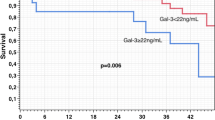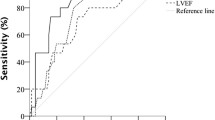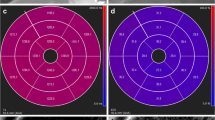Abstract
This study was aimed at determining whether late gadolinium enhancement (LGE) in conjunction with Galectin-3 (Gal-3) level offered more precise prognosis of non-ischemic cardiomyopathy (NICM) in comparison to LGE alone. Results of LGE and Gal-3 expression in 192 patients with NICM, including 85 subjects with dilated cardiomyopathy (DCM) and 107 with hypertrophic cardiomyopathy (HCM), were examined. As suggested by the characteristics of LGE and Gal-3 levels, patients were divided into four groups: LGE positive + low Gal-3 (n = 10 for DCM, n = 15 for HCM), LGE positive + high Gal-3 (n = 25 for DCM, n = 51 for HCM), LGE negative + low Gal-3 (n = 32 for DCM, n = 29 for HCM), LGE negative + high Gal-3 (n = 18 for DCM, n = 12 for HCM). Primary endpoints over the follow-up period included major adverse cardiac events (MACEs). Kaplan–Meier survival analysis and univariate Cox proportional hazard models were used to analyze the survival status of patients with NICM. The optimal cut-off value of Gal-3 level for two types of NICM was determined by receiver operating characteristic analysis (13.38 U/L for DCM and 14.40 U/L for HCM). The combination of LGE and Gal-3 levels offered a more significant prognostic value than using LGE alone for both DCM and HCM (DCM P = 0.001 < 0.012; HCM P = 0.037 < 0.040). Moreover, the Cox proportional hazard model suggested that both LGE status [Hazard ratio (HR) = 2.62, P = 0.017] and Gal-3 level (HR = 1.16, P = 0.013) were significant predictors of MACEs in DCM, while they did not appear to have significant prognostic values for HCM (P = 0.06 and 0.64). Furthermore, the multivariate analysis only confirmed LGE as an independent element in predicting prognosis of DCM (HR = 12.19, P = 0.026). In conclusion, LGE status was an independent indicator of DCM prognosis, yet the insignificant role of LGE in HCM prognosis could be limited by sample size.



Similar content being viewed by others
References
Smith N, Steeds R, Masani N et al (2015) A systematic approach to echocardiography in hypertrophic cardiomyopathy: a guideline protocol from the british society of echocardiography. Echo Res Pract 2:G1–G7. doi:10.1530/ERP-14-0115
Khan R, Massel D, Stirrat J et al (2013) Myocardial fibrosis and quality of life in patients with non-ischemic cardiomyopathy: a cardiovascular magnetic resonance imaging study. Int J Cardiovasc Imaging 29:395–404. doi:10.1007/s10554-012-0107-4
Maron BJ, Towbin JA, Thiene G et al (2006) Contemporary definitions and classification of the cardiomyopathies: an american heart association scientific statement from the council on clinical cardiology, heart failure and transplantation committee; quality of care and outcomes research and functional genomics and translational biology interdisciplinary working groups; and council on epidemiology and prevention. Circulation 113:1807–1816. doi:10.1161/CIRCULATIONAHA.106.174287
Basso C, Thiene G, Corrado D et al (2000) Hypertrophic cardiomyopathy and sudden death in the young: pathologic evidence of myocardial ischemia. Hum Pathol 31:988–998. doi:10.1053/hupa.2000.16659
Mann DL, Bristow MR (2005) Mechanisms and models in heart failure: the biomechanical model and beyond. Circulation 111:2837–2849. doi:10.1161/CIRCULATIONAHA.104.500546
Masci PG, Schuurman R, Andrea B et al (2013) Myocardial fibrosis as a key determinant of left ventricular remodeling in idiopathic dilated cardiomyopathy: a contrast-enhanced cardiovascular magnetic study. Circ Cardiovasc Imaging 6:790–799. doi:10.1161/CIRCIMAGING.113.000438
Olivotto I, Maron BJ, Appelbaum E et al (2010) Spectrum and clinical significance of systolic function and myocardial fibrosis assessed by cardiovascular magnetic resonance in hypertrophic cardiomyopathy. Am J Cardiol 106:261–267. doi:10.1016/j.amjcard.2010.03.020
Wu TJ, Ong JJ, Hwang C et al (1998) Characteristics of wave fronts during ventricular fibrillation in human hearts with dilated cardiomyopathy: role of increased fibrosis in the generation of reentry. J Am Coll Cardiol 32:187–196
Pogwizd SM, McKenzie JP, Cain ME (1998) Mechanisms underlying spontaneous and induced ventricular arrhythmias in patients with idiopathic dilated cardiomyopathy. Circulation 98:2404–2414
Perazzolo Marra M, De Lazzari M, Zorzi A et al (2014) Impact of the presence and amount of myocardial fibrosis by cardiac magnetic resonance on arrhythmic outcome and sudden cardiac death in nonischemic dilated cardiomyopathy. Heart Rhythm 11:856–863. doi:10.1016/j.hrthm.2014.01.014
White JA, Patel MR (2007) The role of cardiovascular mri in heart failure and the cardiomyopathies. Cardiol Clin 25(71–95):vi. doi:10.1016/j.ccl.2007.02.003
Ahn MS, Kim JB, Joung B et al (2013) Prognostic implications of fragmented qrs and its relationship with delayed contrast-enhanced cardiovascular magnetic resonance imaging in patients with non-ischemic dilated cardiomyopathy. Int J Cardiol 167:1417–1422. doi:10.1016/j.ijcard.2012.04.064
Mewton N, Liu CY, Croisille P et al (2011) Assessment of myocardial fibrosis with cardiovascular magnetic resonance. J Am Coll Cardiol 57:891–903. doi:10.1016/j.jacc.2010.11.013
Bruder O, Wagner A, Jensen CJ et al (2010) Myocardial scar visualized by cardiovascular magnetic resonance imaging predicts major adverse events in patients with hypertrophic cardiomyopathy. J Am Coll Cardiol 56:875–887. doi:10.1016/j.jacc.2010.05.007
Masci PG, Barison A, Aquaro GD et al (2012) Myocardial delayed enhancement in paucisymptomatic nonischemic dilated cardiomyopathy. Int J Cardiol 157:43–47. doi:10.1016/j.ijcard.2010.11.005
Lehrke S, Lossnitzer D, Schob M et al (2011) Use of cardiovascular magnetic resonance for risk stratification in chronic heart failure: prognostic value of late gadolinium enhancement in patients with non-ischaemic dilated cardiomyopathy. Heart 97:727–732. doi:10.1136/hrt.2010.205542
Wu KC, Weiss RG, Thiemann DR et al (2008) Late gadolinium enhancement by cardiovascular magnetic resonance heralds an adverse prognosis in nonischemic cardiomyopathy. J Am Coll Cardiol 51:2414–2421. doi:10.1016/j.jacc.2008.03.018
Assomull RG, Prasad SK, Lyne J et al (2006) Cardiovascular magnetic resonance, fibrosis, and prognosis in dilated cardiomyopathy. J Am Coll Cardiol 48:1977–1985. doi:10.1016/j.jacc.2006.07.049
de Leeuw N, Ruiter DJ, Balk AH et al (2001) Histopathologic findings in explanted heart tissue from patients with end-stage idiopathic dilated cardiomyopathy. Transpl Int 14:299–306
Sharma UC, Pokharel S, van Brakel TJ et al (2004) Galectin-3 marks activated macrophages in failure-prone hypertrophied hearts and contributes to cardiac dysfunction. Circulation 110:3121–3128. doi:10.1161/01.CIR.0000147181.65298.4D
Weir RA, Petrie CJ, Murphy CA et al (2013) Galectin-3 and cardiac function in survivors of acute myocardial infarction. Circ Heart Fail 6:492–498. doi:10.1161/CIRCHEARTFAILURE.112.000146
Dumic J, Dabelic S, Flogel M (2006) Galectin-3: an open-ended story. Biochim Biophys Acta 1760:616–635. doi:10.1016/j.bbagen.2005.12.020
Yang RY, Rabinovich GA, Liu FT (2008) Galectins: structure, function and therapeutic potential. Expert Rev Mol Med 10:e17. doi:10.1017/S1462399408000719
Reifenberg K, Lehr HA, Torzewski M et al (2007) Interferon-gamma induces chronic active myocarditis and cardiomyopathy in transgenic mice. Am J Pathol 171:463–472. doi:10.2353/ajpath.2007.060906
Thandavarayan RA, Watanabe K, Ma M et al (2008) 14-3-3 protein regulates ask1 signaling and protects against diabetic cardiomyopathy. Biochem Pharmacol 75:1797–1806. doi:10.1016/j.bcp.2008.02.003
de Boer RA, Lok DJ, Jaarsma T et al (2011) Predictive value of plasma galectin-3 levels in heart failure with reduced and preserved ejection fraction. Ann Med 43:60–68. doi:10.3109/07853890.2010.538080
Lok DJ, Van Der Meer P, de la Porte PW et al (2010) Prognostic value of galectin-3, a novel marker of fibrosis, in patients with chronic heart failure: data from the DEAL-HF study. Clin Res Cardiol 99:323–328. doi:10.1007/s00392-010-0125-y
Lok DJ, Lok SI, Bruggink-Andre de la Porte PW et al (2013) Galectin-3 is an independent marker for ventricular remodeling and mortality in patients with chronic heart failure. Clinical Res Cardiol 102:103–110. doi:10.1007/s00392-012-0500-y
Elliott PM, Anastasakis A, Borger MA et al (2014) [2014 ESC guidelines on diagnosis and management of hypertrophic cardiomyopathy]. Kardiol Pol 72:1054–1126. doi:10.5603/KP.2014.0212
Kim RJ, Shah DJ, Judd RM (2003) How we perform delayed enhancement imaging. J Cardiovasc Magn Reson 5:505–514
Gao P, Yee R, Gula L et al (2012) Prediction of arrhythmic events in ischemic and dilated cardiomyopathy patients referred for implantable cardiac defibrillator: evaluation of multiple scar quantification measures for late gadolinium enhancement magnetic resonance imaging. Circ Cardiovasc Imaging 5:448–456. doi:10.1161/CIRCIMAGING.111.971549
Morgan RB, Kwong R (2015) Role of cardiac MRI in the assessment of cardiomyopathy. Curr Treat Options Cardiovasc Med 17:53. doi:10.1007/s11936-015-0410-1
Johnston DL, Rokey R, Okada RD (1987) Nuclear magnetic resonance imaging of the cardiovascular system. Herz 12:51–67
Masci PG, Schuurman R, Barison A et al (2013) Response to letters regarding article, “myocardial fibrosis as a key determinant of left ventricular remodeling in idiopathic dilated cardiomyopathy: a contrast-enhanced cardiovascular magnetic study”. Circ Cardiovasc Imaging 6:e79. doi:10.1161/CIRCIMAGING.113.001217
Li X, Cai C, Luo R et al (2015) The usefulness of age and sex to predict all-cause mortality in patients with dilated cardiomyopathy: a single-center cohort study. Clin Interv Aging 10:1479–1486. doi:10.2147/CIA.S88565
Cheng L, Zhao R, Jin Z et al (2015) Association of genetic polymorphisms on btnl2 with susceptibility to and prognosis of dilated cardiomyopathy in a chinese population. Int J Clin Exp Pathol 8:10488–10499
Ismail TF, Prasad SK, Pennell DJ (2012) Prognostic importance of late gadolinium enhancement cardiovascular magnetic resonance in cardiomyopathy. Heart 98:438–442. doi:10.1136/heartjnl-2011-300814
Rodriguez-Capitan J, Garcia-Pinilla JM, Ruiz-Zamora I et al (2015) Reply to the letter “prognostic value of late gadolinium enhancement in cardiomyopathy: causative risk factor or surrogate marker?” Int J Cardiol 181:102–103. doi:10.1016/j.ijcard.2014.12.007
Rodriguez-Capitan J, Garcia-Pinilla JM, Ruiz-Zamora I et al (2014) Long-term prognostic value of late gadolinium enhancement in a cohort of patients with nonischemic dilated cardiomyopathy. Int J Cardiol 177:17–19. doi:10.1016/j.ijcard.2014.09.110
Vergaro G, Del Franco A, Giannoni A et al (2015) Galectin-3 and myocardial fibrosis in nonischemic dilated cardiomyopathy. Int J Cardiol 184:96–100. doi:10.1016/j.ijcard.2015.02.008
Ise T, Hasegawa T, Morita Y et al (2014) Extensive late gadolinium enhancement on cardiovascular magnetic resonance predicts adverse outcomes and lack of improvement in LV function after steroid therapy in cardiac sarcoidosis. Heart 100:1165–1172. doi:10.1136/heartjnl-2013-305187
Gucuk Ipek E, Akin Suljevic S, Kafes H et al (2015) Evaluation of galectin-3 levels in acute coronary syndrome. Ann Cardiol Angeiol doi:10.1016/j.ancard.2015.09.046
Yakar Tuluce S, Tuluce K, Cil Z et al (2015) Galectin-3 levels in patients with hypertrophic cardiomyopathy and its relationship with left ventricular mass index and function. Anatol J Cardiol. doi:10.5152/AnatolJCardiol.2015.6191
Cuspidi C, Tadic M, Sala C (2015) Galectin-3 and hypertensive heart disease. J Clin Hypertens (Greenwich). doi:10.1111/jch.12756
French B, Wang L, Ky B et al (2015) Prognostic value of galectin-3 for adverse outcomes in chronic heart failure. J Card Fail. doi:10.1016/j.cardfail.2015.10.022
Guglin M, Verma S (2012) Right side of heart failure. Heart Fail Rev 17:511–527. doi:10.1007/s10741-011-9272-0
Freed BH, Gomberg-Maitland M, Chandra S et al (2012) Late gadolinium enhancement cardiovascular magnetic resonance predicts clinical worsening in patients with pulmonary hypertension. J Cardiovasc Magn Reson 14:11. doi:10.1186/1532-429X-14-11
Author information
Authors and Affiliations
Corresponding author
Ethics declarations
Conflict of interest
All Authors have no conflicts of interest to disclose.
Rights and permissions
About this article
Cite this article
Hu, DJ., Xu, J., Du, W. et al. Cardiac magnetic resonance and galectin-3 level as predictors of prognostic outcomes for non-ischemic cardiomyopathy patients. Int J Cardiovasc Imaging 32, 1725–1733 (2016). https://doi.org/10.1007/s10554-016-0958-1
Received:
Accepted:
Published:
Issue Date:
DOI: https://doi.org/10.1007/s10554-016-0958-1




